Halloween is here, and I’ve been replaying (Super) Castlevania IV over the past several days. I’ve beaten the game years ago, and replayed parts of it many times over the years (often around Halloween), but this might be just the 2nd time I’ve fully played through the entire game. Since I got the SNES Classic not long ago, I figured this would be the ideal game to play.
The early levels are quite familiar to me, and easy to breeze through. My favorite level of all is the cavern in Stage 3.
I absolutely love the music in this game. In fact, I’m playing the video above now just to hear the music as I type. 😀
Stage 4 is also home to some very memorable levels. The first level here (4-1) has skulls on the wall that turn to follow your movement. Even though you can’t kill them or interact with them, I always thought that was a cool detail.
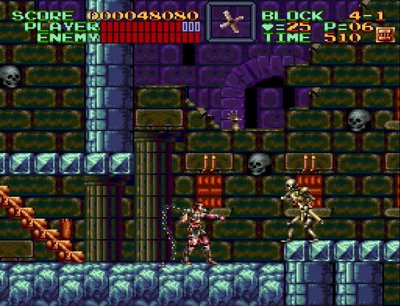
Stage 4-2 uses Mode 7 graphics to make the entire level rotate as you hang by your whip. The next level, Stage 4-3, puts you in a large cylindrical room that rotates as you play. It’s a very cool effect, although it can be distracting if you’re playing it for the first time.
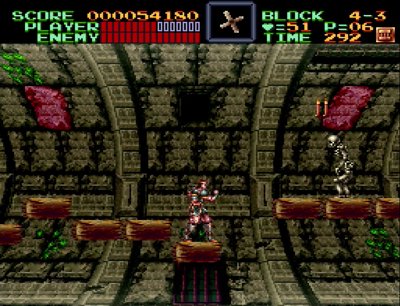
Stage 6-1 features some huge chandeliers that swing from side to side. You have to jump across them, and then onto more chandeliers. Konami took advantage of some SNES hardware features to make some really unique levels in this game.
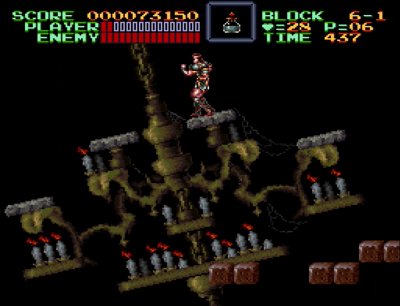
As I progressed through Stage 6 and into Stage 7, the levels were less familiar to me. Most of the previous times I’ve played through this game (at least in recent years), I’ve only played through the first several levels. Often I’d stop after Stage 4 or 5. So I had forgotten about the paintings in Stage 7-2; they’ll grab you by the neck!
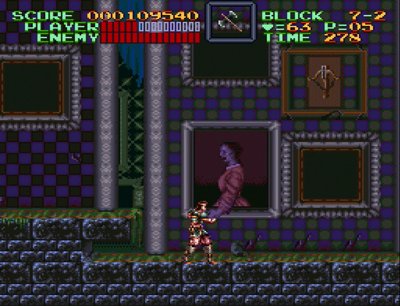
I also enjoyed the music in this stage, and it likely has been years since I’ve heard it.
Things were going smoothly until I reached Stage 8. The levels here (8-1 and 8-2) have various types of dangerous spikes. Some are on moving platforms, some swing from side to side, and some fall from the ceiling. But they all have one thing in common: They will kill you in one hit. What makes it even worse is that the hit detection seems a bit unfair.
I died many times in this stage, and had to continue quite a few times as well. Even though the SNES Classic has save points, I don’t want to abuse that feature. I wanted to get through the stage legitimately, and eventually, I did. 😛
As a reward for completing that tough stage, you go on to Stage 9…one of my favorite stages in the game. It’s a beautiful, colorful stage, littered with piles of gold and treasure chests everywhere. Ghosts rise to the ceiling endlessly (they can’t hurt you), and gold nuggets spring up like popcorn every time you walk over a treasure chest. It’s a fun, playful level that’s such a stark contrast to Stage 8 before it.
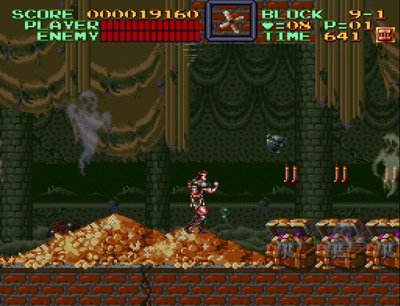
Next up is Stage A, the clock tower, and then Stage B marks the final march into Dracula’s castle. It ends in a series of boss fights, which are challenging but not overwhelmingly difficult. Of course, it helps that each continue lets you resume at the boss you were fighting, rather than putting you back at the beginning of Stage B.
Fittingly, I beat Dracula (and the game) today, on Halloween. I’ve enjoyed my journey, and I may re-play this game again in the future, on some October night years from now.
I hope you’ve all enjoyed your Halloween and had a great time. 🙂
Just a couple of notes. I’ve added a new Halloween tag to this blog, for posts like this one. Posts near Halloween season that cover spooky-themed games like Castlevania, Doom, Haunted House, and more. Also, feel free to check out my page of Halloween game reviews.